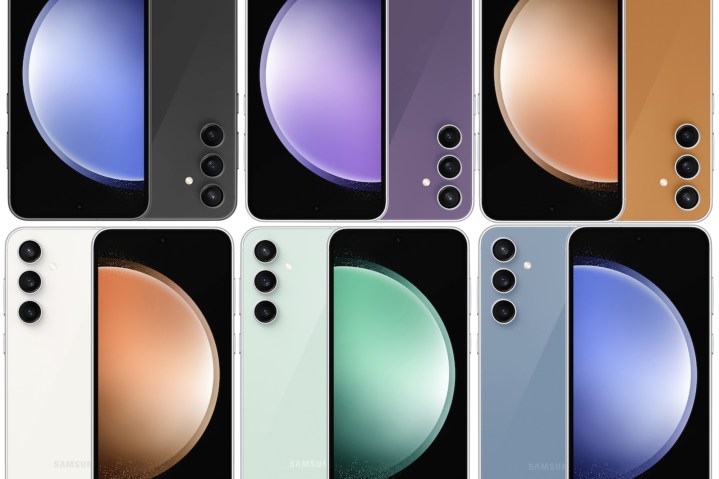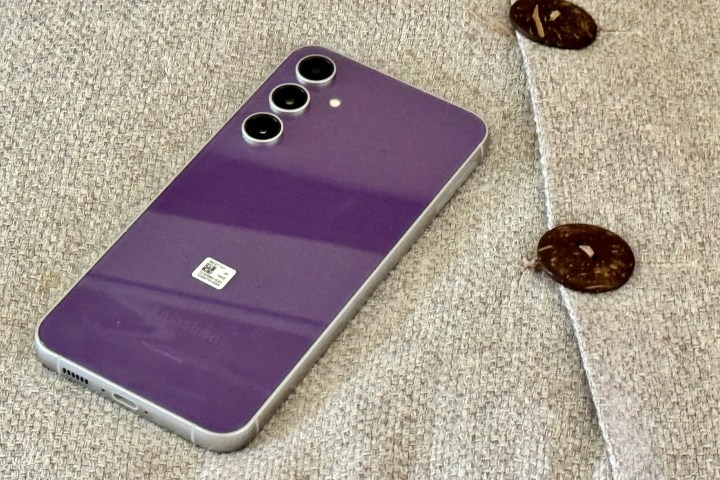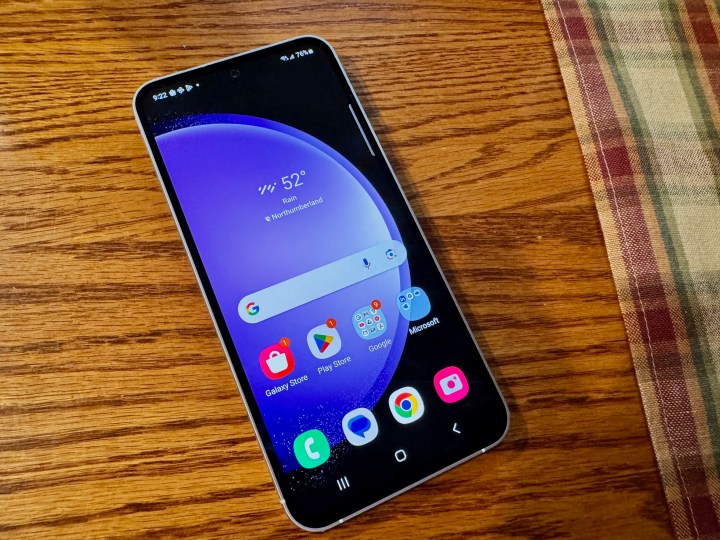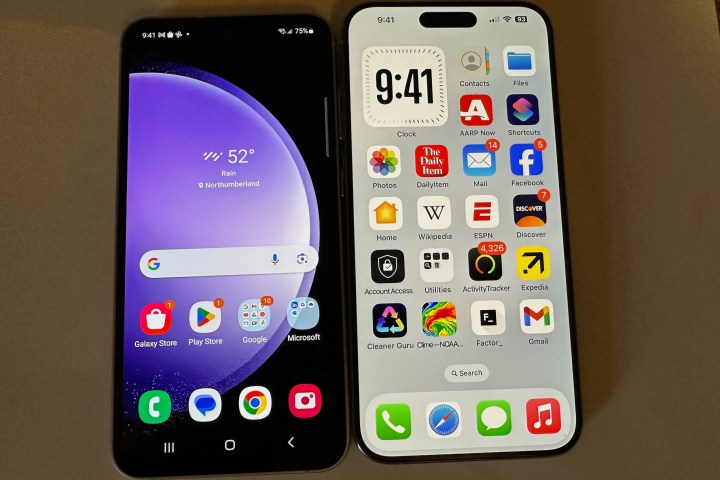
As an avid Apple fan, I was surprised when I received the Samsung Galaxy Tab S9 FE for review and found myself loving it. Could Samsung continue to impress me? That’s what I wanted to find out when I received the Galaxy S23 FE. This “fan edition” smartphone, which we just ran through its paces in our Samsung Galaxy S23 FE review, offers many of the same features as the other Galaxy S23 models, but at a slightly lower price.
My handset of choice has always been the latest iPhone Pro. This usually means purchasing the Pro Max model, which I did again this year with the iPhone 15 Pro Max. I didn’t expect the Galaxy S23 FE to match up to my new iPhone, as the Apple device is double the price and offers much better specs.
However, I was interested in knowing whether the S23 FE had just enough features where I wouldn’t have a problem doing everyday tasks on it like checking email, making phone calls, surfing the web, watching a few videos, etc. How did the S23 FE hold up? Pretty well, although there’s one important thing that held it back for me.
What I love about this Android phone

Samsung has a history of releasing “fan edition” products like smartphones. While some of these products have been well-received, others have not. The Galaxy S20 FE, for example, received high praise in 2020, including being called the “phone to beat for under $700” by Digital Trends. However, when the Galaxy S21 FE 5G was launched, it received less favorable reviews — with our reviewer noting that “the sequel is never as good.” The S21 FE 5G’s poor reception may have convinced Samsung not to release an S22 FE. Nevertheless, skipping to the S23 FE seems to have been worth it, as the handset boasts many excellent features.
The first thing you’ll notice about the Galaxy S23 FE is its impressive 6.4-inch Dynamic 2X AMOLED display with a peak refresh rate of 120Hz. The S23 FE’s display delivers vibrant and crisp visuals and the colors pop. The Galaxy S23 FE’s display is larger than the one found on the 6.1-inch Galaxy S23 and smaller than the one on the 6.6-inch Galaxy S23 Plus.
The iPhone Pro series has also included a 120Hz refresh rate for many years. Unfortunately, the same can’t be said for regular iPhones. Like their predecessors, the iPhone 15 and iPhone 15 Plus are stuck at 60Hz. So yes, call this Apple user impressed.
Call this Apple user impressed.
I have always admired the wide range of color options available on Android devices, especially those manufactured by Samsung. Unlike Apple, which usually offers conservative color choices for its iPhones, Samsung consistently provides more vibrant and appealing options.

The Galaxy S23 FE, for instance, comes in some really excellent color choices. Apart from the usual graphite and cream, you can also purchase the phone in mint, purple (the color of my review unit), and exclusively through Samsung.com, tangerine and indigo. Sure, like most people, you probably slap a case on your new smartphone as soon as you make the purchase. Regardless, it’s nice to know there’s something unique inside!
Just look at the S23 FE in purple; impressive, no?

This brings us to the S23 FE’s chip. It includes a Qualcomm Snapdragon 8 Gen 1 chip in the U.S, compared to the Qualcomm Snapdragon 8 Gen 2 chip found on the other S23 models. (An Exynos 2200 chip is featured on the S23 FE in other regions.)
Samsung’s decision to go with the Snapdragon 8 Gen 1 versus the Gen 2 on the S23 FE will undoubtedly turn some heads since the latter is vastly superior. It’s probably one area where the company shouldn’t have cut corners, primarily since the Snapdragon 8 Gen 1 has been known to heat up with overuse.
During my usage of the Galaxy S23 FE, I did not encounter any significant issues with performance when doing everyday tasks. It seamlessly handled duties such as checking emails, sending text messages, opening multiple tabs on Google Chrome, watching videos on YouTube, and playing basic games downloaded from Google Play.

Looking at the cameras found on the S23 FE, it’s worth noting that the phone features a triple camera setup on the back, as is typical for Samsung phones. That includes a 50MP main camera, a 12MP ultrawide camera, and an 8MP telephoto camera. On the front, there is a 10MP fixed-focus camera. I didn’t spend much time taking photos with my review unit, as I knew our reviewer would be doing that. My focus was on seeing what Samsung was offering at this price point.
When comparing the S23 FE’s camera specs to those of the iPhone 15 and iPhone 15 Plus, it’s worth noting that the S23 FE’s specs are slightly better. The iPhone 15 and 15 Plus feature a dual-camera system with a 48MP main camera, a 12MP ultra-wide camera, and a front-facing 12MP TrueDepth camera.
Puzzlingly, Samsung decided not to add autofocusing capabilities like the ones found on more expensive phones — and also on the iPhones.
Where Samsung could improve

I have no significant complaints about the Samsung Galaxy S23 FE, but some areas gave me pause.
First, the bezels are slightly thicker compared to other S23 models. The device features an older version of Gorilla Glass protection, meaning the display might be less protected over time.
However, Samsung’s decision to use the Snapdragon 8 Gen 1 on this model may be the most significant drawback. This chip is almost two generations old, and while I didn’t experience any performance issues doing everyday tasks, it is worth reiterating that this chip has been known to generate excessive heat in overtaxing situations. If you plan on using your phone for a lot of 4K video watching and more than casual gaming, look elsewhere.
An Apple fanboy’s verdict

There’s much I like about the S23 FE, starting with its bright display, unique color choices, and mostly good camera specs. I was also happy with the phone’s build quality. However, I would probably get annoyed by its older chipset with longer-term use. And then there’s the operating system.
I have been using iPhones for an eternity and have become accustomed to iOS. On the other hand, Android, regardless of the version, doesn’t appeal to me. It’s much more challenging to use, lacks the same level of enjoyment, and the Google Play Store feels much more like the Wild West. Android is reason enough why I would never consider switching from the iPhone, even though I recognize the appeal for many who choose Android over iOS.
Here’s my bottom line: If you’re currently using an Android phone and planning to upgrade, I recommend considering the S23 FE. Although it lacks some of the fancy features present in other S23 models, it includes all the essential functionalities and comes at a lower price point, which makes it a great deal. It won’t change you’re mind about Android if you’re an iPhone loyalist like myself, but for everyone else, it’s a decent pickup.
Editors' Recommendations
- Nomad’s new iPhone case and Apple Watch band may be its coolest yet
- 5 phones you should buy instead of the iPhone 15
- iPhone 16: news, rumored price, release date, and more
- iPhone SE 4: news, rumored price, release date, and more
- 3 reasons why I’ll actually use Anker’s new iPhone power bank



